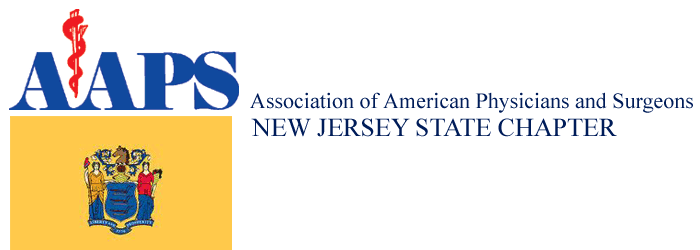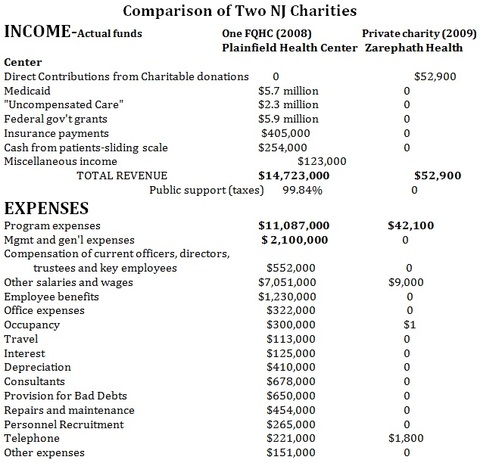A Look at the Numbers Behind Charitable Clinics
 Tuesday, June 26, 2012 at 07:03PM
Tuesday, June 26, 2012 at 07:03PM by Anonymous:
I am not the typical doctor in many respects. A major example is that I no longer work in clinical practice. Several years ago I transitioned into consulting- so now I work in the business aspect of medicine. This has been quite an eye opening (and often mind boggling) experience.
Recently, I learned of AAPS and attended a local conference in New Jersey. I was introduced to Dr Alieta Eck and the Zarephath Health Center- and absolutely fell in love with the concept. I’ve always believed that the more government gets involved in an activity, the more inefficient that activity becomes. Dr Eck is, rightfully, proud to report that the per-patient cost to provide care is much lower at Zarephath than at a neighboring Federally Qualified Health Center (FQHC). Tapping into my inner finance nerd, I wanted to learn more.
As a consultant, I learned to deal with the numbers behind medicine. I also have colleagues who focus on helping hospitals qualify for FQHC status. Why would a hospital be eager to do this? What’s in it for them?
The web site of the Rural Assistance Center (RAC) lays it out nicely. [link - http://www.raconline.org/topics/clinics/fqhcfaq.php#whatis ]By the way, the RAC is a branch of the US Department of Health and Human Services (HHS), which also oversees Center for Medicare and Medicaid Services (CMS). Another given with government is that it doesn’t take long to get into a mire of alphabet soup!
Here is the definition of a FQHC directly from the RAC web site:
“A federally qualified health center (FQHC) is a type of provider defined by the Medicare and Medicaid statutes. FQHCs include all organizations receiving grants under Section 330 of the Public Health Service Act, certain tribal organizations, and FQHC Look-Alikes. Requirements for Indian Health Service funded FQHCs may differ from the requirements for FQHCs receiving Section 330 grants and for FQHC Look-Alikes.”
Benefits, according to the FAQ section of RAC’s web site, include enhanced Medicare and Medicaid reimbursement, eligibility to purchase medications at a reduced cost, and eligibility for various other “grants and programs.”
Sounds awesome, huh? Unless, you’re like me and you think, “Not so fast- what’s the catch?” The catch, as is often the case with government programs, is that there are lots of rules that must be followed. There are rules about the FQHC’s board of directors; hours the clinic must be open, what kind of services must be provided, how many patients each provider can see, and how to structure the fee schedule.
So maybe you’re thinking, “OK, it would be great if it was possible to run a clinic for poor people without government money. But how is that possible? Doesn’t it cost millions of dollars to run a clinic?”
Thankfully, the answer to that question is a resounding “NO”. Zarephath Health Clinic is just one example of a number of clinics run across the country by caring, dedicated volunteers who show us that we don’t need to depend on the government to redistribute tax dollars for us.
Here is a comparison of the finances from Zarephath and a nearby FQHC (click table to enlarge):
Quite a difference, don’t you think? Both clinics seek to do the same thing. Let’s compare the mission statements listed on each web site:
Zarephath Health Center:
The Zarephath Health Center provides free health-care to the poor and uninsured. The World Health Organization defines 'health' as a state of physical, emotional and spiritual well-being. Our goal is to work on all three levels."
Plainfield Health Center:
“The Neighborhood Health Services Corporation's mission is to provide high quality, customer focused, cost-effective primary health care services in a safe and accessible environment for the residents of the City of Plainfield and surrounding communities. NHSC is especially dedicated to providing consistent, high quality primary health care services to the medically needy and indigent populations of these communities.”
This is not meant in any way to be critical of Plainfield Health Center or the work they do. I’m sure everyone involved is compassionate and dedicated to the people they serve.
There is another option- one that doesn’t depend on a government’s ability to raise tax dollars. As the budgets of government at all levels become unsustainable, it’s important to think outside the box and come up with innovative – and cost effective - solutions. Zarephath Health Center, and others like it, are providing not only great medical care and much needed service to the community, they also are blazing the trail for more cost effective ways to provide that service.
 admin | Comments Off |
admin | Comments Off | 





